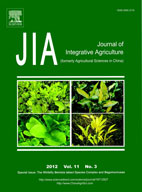|
|
Pharmacokinetics of Cyadox and Its Major Metabolites in Swine After Intravenous and Oral Administration
ZHAO Ning, WANG Lin, LU Xiao-xiong, JIA Hui-qin, FANG Bing-hu, ZENG Zhen-ling , DING Huanzhong
2013, 12(3):
495-501.
DOI: 10.1016/S2095-3119(13)60250-6
Pharmacokinetics of cyadox (CYX) and its major metabolites in healthy swine was investigated in this paper. 1,4- Bisdesoxycyadox (BDCYX), cyadox-1-monoxide (CYX-1-O) and quinoxaline-2-carboxylic acid (QCA), three main metabolites of cyadox, were synthesized by College of Science, China Agricultural University. Cyadox (CYX) was administered to 8 healthy cross-bread swine intravenously (i.v.) and orally (p.o.) at a dosage of 1 mg kg-1 body weight and 40 mg kg-1 body weight respectively in a randomized crossover design test with 2-wk washout period. A sensitive high-performance liquid chromatography-tandem mass spectrometry (LC-ESI-MS/MS) method was developed for the determination of cyadox and its major metabolites in plasma. CYX and its major metabolites BDCYX, and CYX-1-O can be detected after intravenous administration of cyadox while CYX and its metabolites BDCYX, CYX-1-O and QCA can be detected after oral administration of CYX. Plasma concentration vs. time profiles of CYX and its major metabolites were analyzed by non-compartmental pharmacokinetic method. Following i.v. administration, the areas under the plasma concentration-time curve (AUC0- ) were (0.38±0.03) μg mL-1 h (CYX), (0.018±0.002) μg mL-1 h (BDCYX) and (0.17±0.02) μg mL-1 h (CYX-1-O), respectively. The terminal elimination half-lives (t1/2lz) were determined to be (0.93±0.07) h (CYX), (1.45±0.04) h (BDCYX), and (0.92±0.04) h (CYX-1-O), respectively. Steady-state distribution volume (Vss) of (2.14±0.11) L kg-1 and total body clearance (CL) of (2.84±0.19) L h-1 kg-1 were determined for CYX after i.v. dosing. The bioavailability (F) of CYX was 2.85% for oral administration. After single i.v. administration, peak plasma concentrations (Cmax) of (1.08±0.06) μg mL-1 (CYX), (0.0068± 0.0004) μg mL-1 (BDCYX) and (0.25±0.03) μg mL-1 (CYX-1-O) were observed at Tmax of 0.033 h (CYX), 1 h (BDCYX) and 0.033 h (CYX-1-O), respectively. The main pharmacokinetic parameters after p.o. administration were as follows: AUC0- were (0.42±0.04) μg mL-1 h (CYX), (1.38±0.14) μg mL-1 h (BDCYX), (0.59±0.02) μg mL-1 h (CYX-1-O) and (1.48±0.09) μg mL-1 h (QCA), respectively. t1/2lz were (4.77±0.33) h (CYX), (5.77±0.56) h (BDCYX), (4.12±0.28) h (CYX-1-O), and (8.51±0.39) h (QCA), respectively. After p.o. administration, Cmaxs of (0.033±0.002) μg mL-1 (CYX), (0.22±0.03) μg mL-1 (BDCYX), (0.089±0.005) μg mL-1 (CYX-1-O), and (0.17± 0.01) μg mL-1 (QCA) were observed at Tmax of (7.38±0.33) h (CYX), (7.25±0.31) h (BDCYX), (7.38±0.33) h (CYX-1-O), and (7.25±0.31) h (QCA), respectively. The results showed that CYX was slowly absorbed after oral administration and most of CYX was transformed to its metabolites in swine. The area under plasma concentration-time curve (AUC0- )of metabolites were higher than that of CYX after p.o. administration, and the elimination half-lives (t1/2lz) of QCA were longer than those of CYX, CYX-1-O, and BDCYX after oral administration.
|
